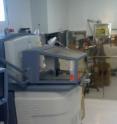New molecular imaging technologies for detecting cellular processes
The work carried out by these scientists has ranged from the initial design of an electronic architecture for gamma ray detectors to industry transfer of a complete scanner, after having adequately validated a prototype through experimental studies at the Gregorio Marañón Hospital. The results of this research, headed by professors Juan José Vaquero and Manuel Desco, from the Department of de Bioengineering and Aerospace Engineering at UC3M, have been recently published in the journals IEEE Transactions on Nuclear Science (two articles) and Physics in Medicine and Biology (one article). The electronic technology equipment designed by the researchers- which is in patent process-is based on molecular imaging, a type of biomedical imaging capable of detecting live cellular processes. "These techniques differ from conventional medical imaging in that the information they show is function not form, which means that they are capable of showing the malfunctioning of an organ before the malfunction turns into an anatomical change", Juan José Vaquero explained. "In other words", he added, "they allow for earlier detection of a possible anomaly, which enormously facilitates treatment". In addition to making an earlier diagnosis possible these types of scanners are used in biomedical research and in pharmaceutical laboratories, for example, to speed up the development of new medicines
The growth of molecular imaging in recent years, according to experts, is chiefly due to the narrowing of the gap between molecular biology and imaging technologies, and it is expected that an acceleration of the transfer of these techniques to clinical practice will be produced. In fact, some of the characteristics of molecular imaging itself are already present in techniques for clinical use in humans such as nuclear medicine imaging or magnetic resonance imaging. "Computerized tomograhy by a sole photon emission, better known by its Anglo-Saxon acronym SPECT, is probably the most widespread molecular imagining technique in clinical practice, and from there stems the interest in having preclinical systems which allow the study of human illnesses to be carried out on animals", Professor Manuel Desco pointed out.
The Department of Bioengineering and Aerospace Engineering at UC3M focuses on the development of preclinical molecular imaging scanners used in research work on animals. Obtaining good quality in these applications constitutes a much more difficult technical challenge than with humans, due to the large difference in size (with animals being approximately 280 times smaller). The research group has completed the development of SPECT type of system for laboratory animals at University installation, which has features placing it among the top on an international scale in terms of facilities and cost.
This UC3M research group, in addition to carrying out research which leads to scientific publications, focuses a large part of its interest on technology transfer so that it can be commercialized. The company, SEDECAL, the largest domestic manufacturer and exporter of electro-medical imaging equipment, is going to commercialize the system in the immediate future. The research team from this Madrid public university continues to work on new developments in the area of technology, in close contact with national industry. Part of the developments are under the framework of the AMIT (Advanced Molecular Imaging Technologies) Project from the most recent CENIT public funding, whose scientific coordination oversees this equipment at the UC3M.
Source: Carlos III University of Madrid
Other sources
- New molecular imaging technologies for detecting cellular processesfrom PhysorgTue, 11 Jan 2011, 16:00:37 UTC
